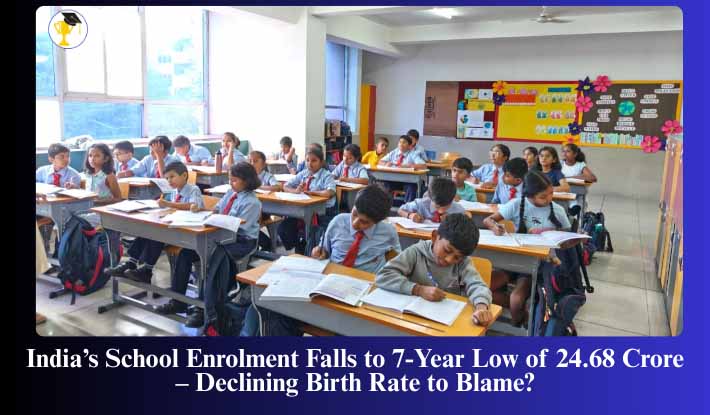India’s School Enrolment Falls to 7-Year Low of 24.68 Crore – Declining Birth Rate to Blame?
India’s School Enrolment Falls to 7-Year Low of 24.68 Crore — Declining Birth Rate at the Core
New Delhi, August 31, 2025 – India’s total school enrolment has dropped to 24.68 crore in 2024–25, marking the lowest level in seven years, according to the Ministry of Education’s UDISE+ data. Experts attribute this decline to the country’s falling fertility rate, which is reshaping classrooms, educational planning, and even future demographic patterns.
Falling Fertility, Shrinking Classrooms
The steep fall in enrolment is closely tied to India’s declining birth rate, with the Total Fertility Rate (TFR) now at 1.91 children per woman—below the replacement level of 2.1. Fewer births are translating directly into smaller classroom sizes, particularly in the early grades, reducing the number of new entrants into the school system.
Gains at Higher Levels, but Primary Enrolment Dips Sharply
The overall decline of 11 lakh students since last year was concentrated in Classes 1–5, where nearly 34 lakh fewer students enrolled. However, enrolments at the secondary and higher secondary levels recorded gains, reflecting improved transition rates as more children continue their education into senior grades. This dual trend highlights a paradox: while fewer children are entering schools, those who do are more likely to progress further.
Dropout Rates Fall, Retention Improves
Despite the shrinking numbers, dropout rates have seen a consistent decline across all levels. Student retention has improved significantly, thanks to policies such as the Right to Education Act, the mid-day meal scheme, targeted scholarships, and better community awareness of the value of education. These efforts are ensuring that once children enter school, they are more likely to stay enrolled.
Regional Contrasts: Southern States See Sharper Declines
The enrolment decline is more pronounced in southern states like Kerala, Tamil Nadu, and Andhra Pradesh, where fertility rates fell earlier and faster. Meanwhile, states such as Uttar Pradesh and Bihar continue to record high student numbers, though their enrolments too are expected to slow in the coming years as demographic transitions spread nationwide.
Teacher Strength Crosses 1 Crore Mark
In a positive milestone, the number of school teachers in India crossed one crore in 2024–25, improving the pupil–teacher ratio (PTR) nationwide. According to official data, PTRs now stand at 10 in foundational grades, 13 in preparatory, 17 in middle school, and 21 at the secondary level—all comfortably below the NEP 2020 benchmark of 30. This means smaller class sizes and greater scope for individualised teaching.
Policy Implications: From Ageing to Political Representation
The fall in enrolment carries implications well beyond education. It reflects India’s demographic transition, raising concerns about future workforce availability, ageing populations, and regional imbalances. Policymakers are also mindful that lower enrolment in southern states could affect political representation in the long term, as population figures guide seat distribution in Parliament.
India’s school enrolment decline to a seven-year low of 24.68 crore underscores the deep impact of demographic changes on education. While smaller classrooms and more teachers per student could enhance learning quality, the broader implications for labour supply, economic planning, and governance are profound. The upcoming 2026 Census will provide a clearer picture, but the trend signals a new chapter in India’s social and demographic journey.
 STUDY MATERIALS
STUDY MATERIALS
 ONLINE COURSES
ONLINE COURSES
 MORE
MORE


